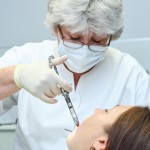
Extraction of third molars is a common procedure often performed under local anaesthesia. A number of different anaesthetic drug area available and while lidocaine has been used in dentistry for many years articaine and bupivacaine have recently been researched more extensively.
The aim of this review was to assess the effectiveness of different anaesthetic solutions for pain control immediately after the extraction of lower third molars.
Methods
Searches were conducted in the PubMed, Scopus, LILACS, Cochrane Library, SciELO, Embase, Web of Science, OpenThesis and OpenGrey databases with no restrictions on language or date of publication. Randomised controlled trials (RCTs) in adults (18-59 yrs of age) undergoing extraction of partially or completely impacted third molars with any anaesthetic solution were considered. Two reviewers selected studies and extracted data with disagreements being resolved by a third reviewer. Risk of bias was assessed by two reviewers independently using a Joanna Briggs Institute assessment tool. A network meta-analysis was conducted with different concentrations of anaesthetics (eg, lidocaine 2% and lidocaine 4%) being treated as separate protocols. However, studies using the same type of vasoconstrictor but at different concentrations were treated as the same protocol (eg, lidocaine 2% with adrenaline 1:100,000 and lidocaine 2% with adrenaline 1:50,000). Standardised mean differences (SMD) and their 95% confidence intervals (CI) were calculated for pain scores.
Results
- 45 studies were included with 13 contributing to the network meta-analysis (NMA).
- 9 difference anaesthetic agents were reported articaine, bupivacaine, centbucridine, etidocaine, levobupivacaine, lidocaine, mepivacaine, ropivacaine, and prilocaine.
- Only 4 studies reported following the CONSORT statement.
- 19 studies were considered to be at low risk of bias, 26 at moderate risk and none at high risk.
- NMA showed that 2% lidocaine + clonidine presented the lowest pain scores (SMD = – 1.44; – 2.72 to – 0.16) compared to 4% articaine + adrenaline, followed by 0.5% bupivacaine + adrenaline (SMD = – 1.36; – 2.13 to – 0.59).
- The overall certainty of the evidence was very low to moderate.
Conclusions
The authors concluded: –
Based on the evidence obtained, the use of 0.5% bupivacaine presents satisfactory results in reducing postoperative pain in the exodontia of third molars, with moderate certainty of evidence. Despite superior results, the use of 2% lidocaine associated with clonidine should be recommended with caution due to the low certainty of evidence and limited commercialisation.
Comments
The reviewers have searched a wide range of databases with no restrictions on language or year of publication. Although 45 studies were included in the review only 13 studies involving a total of 574 patients could be included in the NMA. 4% articaine and adrenaline was used as the reference treatment as it was the most frequently used in the included studies. In all 14 different local anaesthetic agents were tested most comparison being between 2% lidocaine + adrenaline and 4% articaine + adrenaline. This review has focused on the impact of local anaesthetics on post procedure pain and it is reported as SMD and while significant it would have been helpful to have some discussion of the clinical relevance of a 1.44 SMD reduction.
Previously (Dental Elf – 21st Sep 2020) we looked at another NMA of local anaesthesia for inferior alveolar nerve blocks which focused on efficacy and safety. That review included 24 RCTs and suggested that 4% articaine was the most effective. Prior to that a 2018 Cochrane review of local anaesthetics for preventing pain during dental treatment (Dental Elf – 18th Jul 2018) included 123 studies with 68 contributing to a meta-analysis which did suggest some potential superiority for some types of anaesthetics in some clinical situations. Most of these reviews identified studies which could not be included in meta-analysis so more high quality, well reported studies of appropriate size that use common outcomes sets to better support met-analysis are needed to clarify the evidence.
Links
Primary Paper
Rossi MT, de Oliveira MN, Vidigal MTC, de Andrade Vieira W, Figueiredo CE, Blumenberg C, de Almeida VL, Paranhos LR, Oliveira LB, Siqueira WL, de Brito Júnior RB. Effectiveness of anesthetic solutions for pain control in lower third molar extraction surgeries: a systematic review of randomized clinical trials with network meta-analysis. Clin Oral Investig. 2021 Jan;25(1):1-22. doi: 10.1007/s00784-020-03675-w. Epub 2020 Nov 8. PMID: 33161499.
Other references
Dental Elf – 21st Sep 2020
Third molars: Which local anaesthetic is most suitable for inferior alveolar nerve blocks?
Dental Elf – 30th Nov 2018
Dental Elf – 18th Jul 2018
Local anaesthetics for preventing pain during dental treatment
